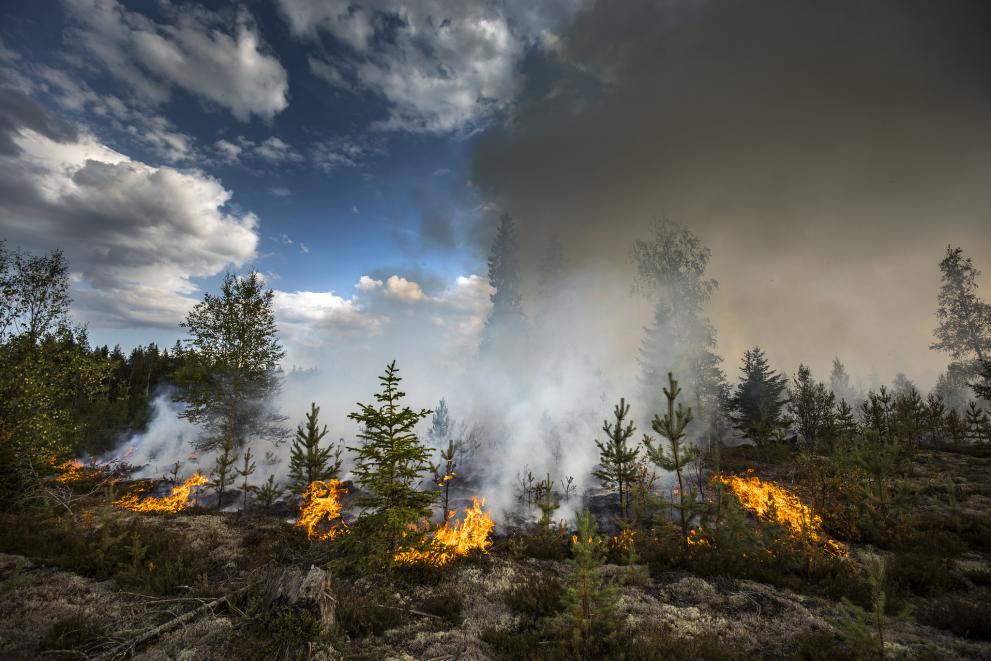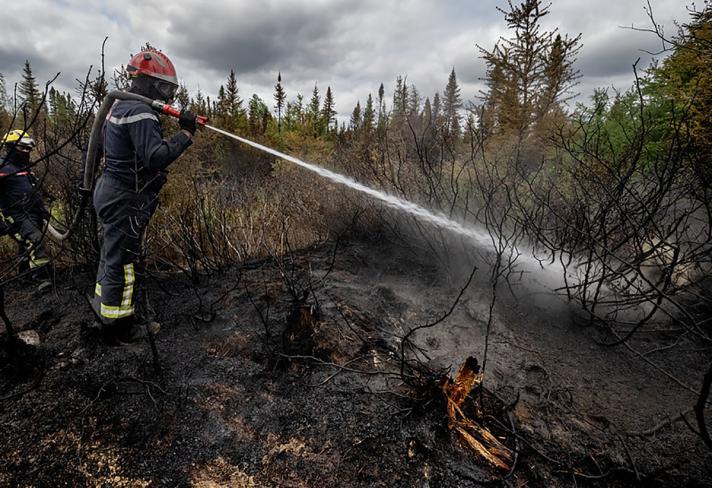What is it?
Wildfires are uncontrolled fires that occur in nature and are often harshened by climatic conditions. Long dry spells particularly increase the risk of wildfires breaking out, but other factors also have a huge impact, such as rain and wind, vegetation, the layout of the terrain, and forest management practices.
2023 was a record-breaking year, with the largest fire ever in Europe, one of the worst wildfire seasons on record in the EU. Wildfires also severely affected Northern America, as well as many countries in Southern America. Lives were lost, livelihoods destroyed, and many hectares of land burnt all over the world.
Last year, he EU reinforced its rescEU firefighting fleet (firefighting planes and helicopters) as well as prepositioned hundreds of firefighters for immediate support in forest fires-prone countries. The EU Civil Protection Mechanism was activated 10 times to respond to wildfires in the Mediterranean, Chile, Bolivia and Canada. In 2024, the same level of response will be maintained.
Why is this important?
The fire risk is expected to further increase due to climate change. The season will be increasingly characterised by massive fires that cost lives and burn areas that take longer to fully recover. Between 2007 and 2023, over 16% of all requests for assistance through the EU Civil Protection Mechanism were in response to wildfires.
Wildfires have recently become a pan-European concern. In 2022, although France, Spain and Portugal were particularly hit, major fires also took place in Czechia, Germany, Greece, and Slovenia, to name a few.

In August 2022, several devastating fires burned large areas of forest in France and forced people to flee their homes.© European Union, 2022 
In August 2021, immense forest fires broke out in various locations in Greece, including forests close to the city of Athens, on the Peloponnese, on Evia, Rhodes and Crete.© Hellenic Fire Corps (photographer: George Chionidis) 
In 2018, Sweden experienced one of its most severe wildfire seasons. In the picture, the view of a burning forest in Kårböle.© European Union, 2018 (photographer: Pavel Koubek)
In total, 20 EU Member States recorded more burned areas than average in 2022.
The wildfire risk expanded to areas that have not previously been exposed, moving well beyond the Mediterranean region. This causes huge societal, environmental, climate and economic losses across Europe.
In 2023 the EU’s Emergency Response Coordination Centre (ERCC) channelled assistance to Albania, Bolivia, Canada, Chile, Cyprus and Greece and Tunisia.
Furthermore, the Copernicus Emergency Management Service (EMS) regularly produces satellite maps on demand to help national authorities respond to wildfires. In the same year, Copernicus has been activated 25 times for wildfires across the globe.
In 2023, both the number of fires and the EU’s annual burnt area were above average.
How are we helping?
The EU Civil Protection Mechanism coordinates pan-European assistance and ensures that all EU Member States and participating states to the Mechanism receive timely information in times of crises and emergencies. Upon its activation by any country worldwide, the Mechanism ensures the rapid deployment of resources and personnel that are tailor-made to fit the needs of each emergency.
At the operational heart of the Mechanism lies the European Commission's Emergency Response Coordination Centre (ERCC). The Centre monitors wildfire risks and emergencies across Europe, supported by national and European monitoring services such as the European Forest Fire Information System (EFFIS).

At the onset of the wildfire season each year, the Centre engages with national authorities from EU Member States and participating states. The aim is to exchange information on the status of prevention, preparedness and response activities and maintains close contact with national authorities throughout the wildfire season.
When national response resources are overwhelmed by fire intensity, countries can activate the EU Civil Protection Mechanism. They can ask for a coordinated, rapid and effective international response.
When fires of such magnitude occur, Member States and participating states in the Mechanism regularly show solidarity by sending assistance in the form of firefighting planes, helicopters, firefighting equipment, and teams.
Additionally, the Mechanism can co-finance the transport of assistance to the affected area as well as operational costs.
Preparing for the 2024 wildfire season
Since 2019, the EU Civil Protection Mechanism has been reinforced with the rescEU fleet, an European reserve that includes firefighting planes and helicopters and is 100% financed by the EU. The EU also co-finances the stand-by availability of additional aerial firefighting capacities to address potential shortcomings in responding to fires.

For the 2024 wildfire season, Cyprus, Czechia, Germany, Greece, Spain, France, Croatia, Italy, Portugal and Sweden put together 24 firefighting planes and 4 helicopters at the disposal of other EU Member States in case of an emergency.
In addition, 556 firefighters are pre-positioned in France, Greece, Portugal and Spain coming from 12 different European countries.
Furthermore, the European Civil Protection Pool counts with 4 firefighting planes, 13 ground firefighting teams, and 1 team of experts.
In addition to the response, the EU supports and complements prevention and preparedness efforts of these States by focusing on areas where a joint European approach is more effective than separate national actions. These include risk assessments to identify the disaster risks across the EU, encouraging research to promote disaster resilience and reinforcing early warning tools.
Prevention, preparedness and response work hand in hand to save human lives and limit the further spread of fires. Having experienced wildfire experts, well-trained firefighters, technology, and other assets available near the location of action makes a difference.
While the national and regional authorities of these States manage wildfire prevention, preparedness and response activities, the EU can co-finance and coordinate further support when needed.
Operations in 2023
In 2023, the EU Civil Protection Mechanism was activated 10 times for wildfires:

Forest fires in Chile
Beginning on February 2nd, many forest fires wreaked devastation 100 kilometres east of Santiago, Chile. The nation requested aid in putting out the flames.
Spain sent out a Forest Fire Assessment Team (FAST) as part of the European Civil Protection Pool, while Italy sent Chile a Technical Assistance and Support Team. Portugal and France dispatched firefighters to assist in the country's firefighting efforts.
Canada forest fires
In May, many forest fires devastated Canada, prompting the nation to request assistance in battling the outbreak.
On 8 June, France dispatched 109 firemen in response to the request. 2 large fires that were 2,873 hectares and 26,749 hectares in size were put out with the team's assistance.
Portugal moved 30 firefighters to Canada on 14 June as part of the European Civil Protection Pool, following suit, as well 110 spontaneous first responders. In addition to saving a community, the firemen assisted in containing and putting out 2 large fires that totalled 481,096 hectares and 7,918 hectares.
In total, 349 first responders from France, Spain, and Portugal have been deployed to help combat the forest fires in Canada.
On 28 and 29 June, all 3 teams left Canada and arrived back at their respective bases.
Wildfires in Tunisia and Italy
In late July, forest fires broke out in northwest Tunisia. The country activated the EU Civil Protection Mechanism and 2 Canadair firefighting planes from the rescEU reserve hosted by Spain were deployed. When at the same time forest fires broke out in Italy on 25 July, Italian authorities conveyed a request for assistance to the EU. However, Italy closed the request after a few hours.
Forest Fires in Greece and Cyprus
Following severe wildfires breaking out in Cyprus, early August, Greece provided the country with aerial firefighting support.
Later the same month, Greece itself faced substantial fires and triggered the EU Civil Protection Mechanism. The country submitted a request for assistance with both on-the-ground and aerial firefighting on 20 August.
Several capabilities from the European Civil Protection Pool were sent to Greece in response to the request. While Poland and Bulgaria dispatched 2 firefighting teams complete with vehicles, Spain sent a Forest Fire Assessment Team and France moved aerial firefighting capabilities to Greece. In response, around 660 first responders with 55 vehicles, 12 firefighting planes and 1 helicopter from the EU supported Greece to put out the flames in the impacted nations.
Wildfires in Albania
On 1 October, Albania activated the EU Civil Protection Mechanism and 2 Canadair firefighting planes from Greece which are part of the ECPP were deployed the next day.
Wildfires in Bolivia
Ground forest fire fighters from France, together with a drones unit were deployed to Bolivia on 24 November, following a request for assistance from the Bolivian authorities.
Last updated: 14/05/2024
Facts & figures
Wildfires affect all European Union territories, from north to south, east to west
Wildfire prevention, preparedness and response activities are closely intertwined
Upon request, the EU Civil Protection Mechanism helps to coordinate rapid support for wildfires
The rescEU firefighting fleet boosts the EU’s ability to prepare for and respond to wildfires

